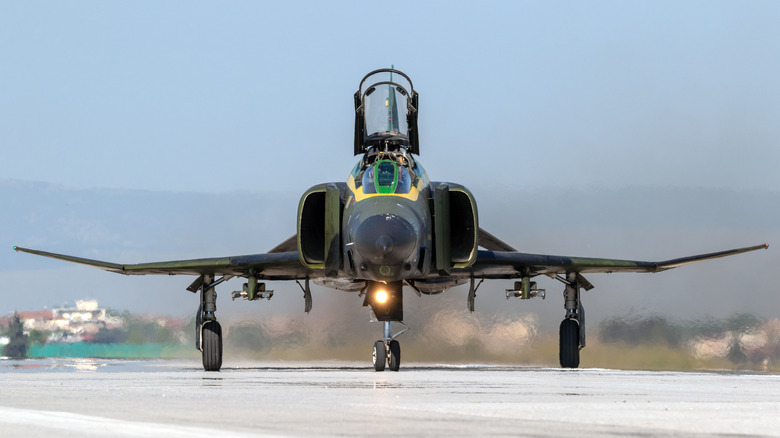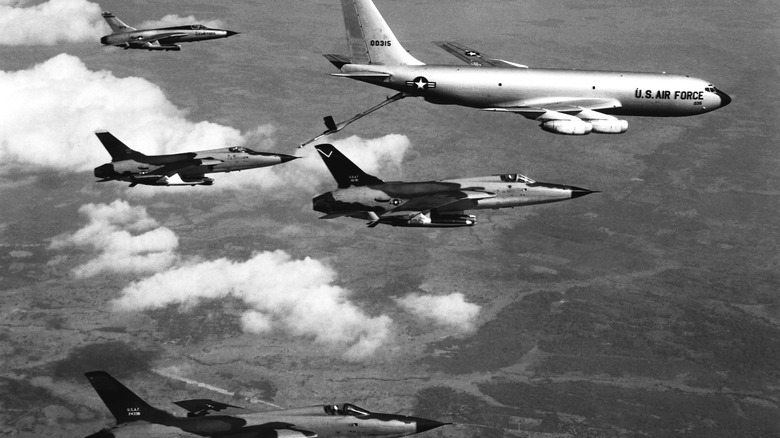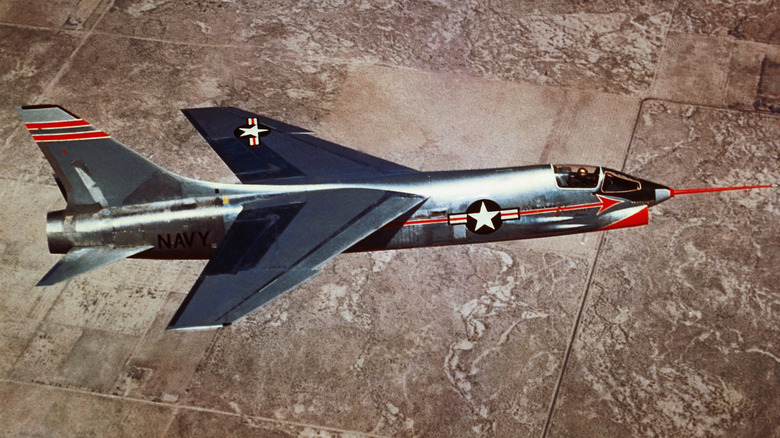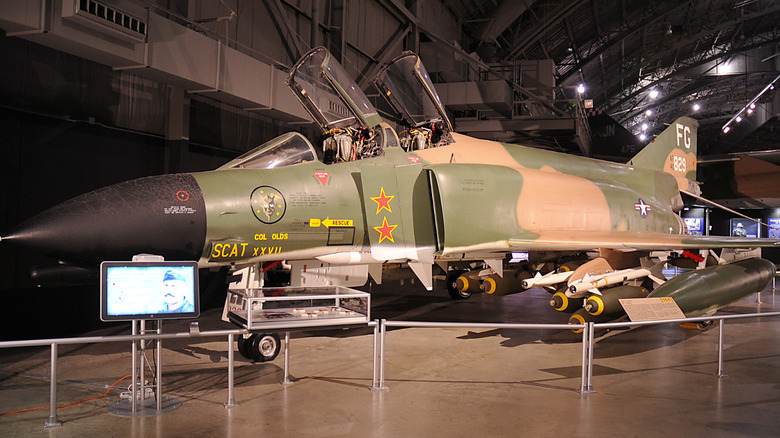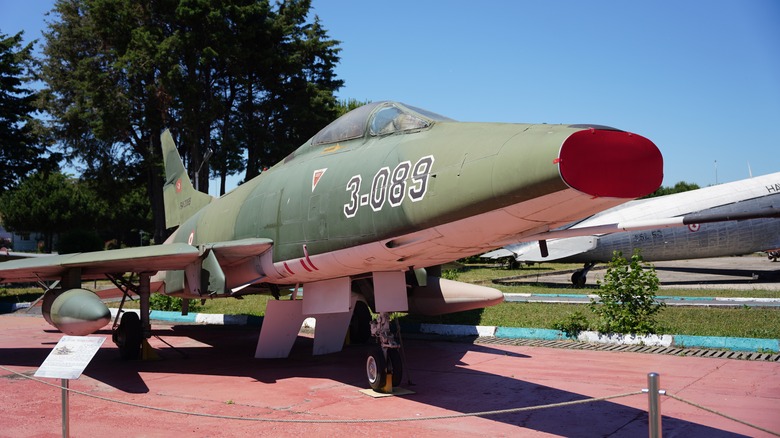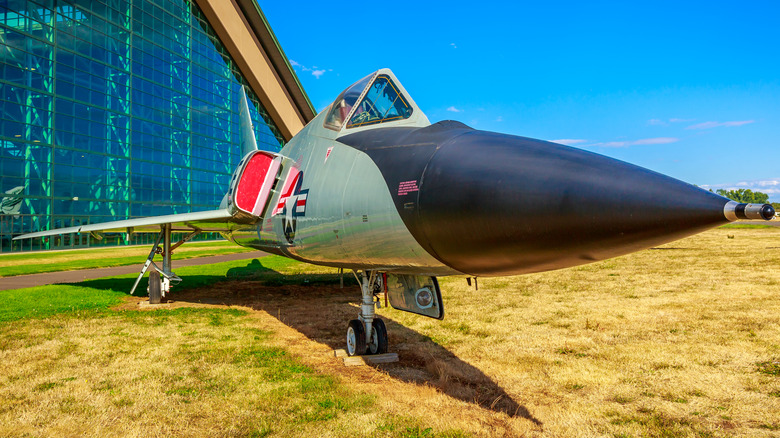5 Fighter Jets Used In The Vietnam War
After the conclusion of World War II, tensions in Southeast Asia grew as France attempted to reestablish colonial rule over Vietnam. The consequences of these efforts would lead to the Vietnam War, a brutal conflict that would endure for decades. Although the U.S. became actively involved in the war in 1961, it wasn't until 1964 that it launched its Air Force against North Vietnam. A number of iconic aircraft participated in the war, showcasing not only the ingenuity of the Air Force's planes but also the bravery and skill of the pilots who flew them.
The U.S. aircraft deployed during the war ranged from helicopters like the Bell UH-1 Iroquois (Huey) to heavy bombers like Boeing's B-52 Stratofortress. Each of these aircraft altered the course of the war, from taking down North Vietnamese troops and vehicles to conducting reconnaissance and flying over the battlefield in order to distinguish the enemy from friendlies. However, when discussing American jets that made a difference during the Vietnam war, the fighters, renowned for their speed and firepower, are hard to overlook. Today, we will explore five iconic fighter jets that flew in Southeast Asian skies between 1964 and 1975.
Republic F-105D Thunderchief
When Republic Aviation designed the original F-105 Thunderchief in 1951, it aimed to create a jet-powered fighter bomber capable of not only flying at supersonic speeds but also carrying nuclear weapons as part of its arsenal. The jet was meant to replace Republic's F-84F, a formidable aircraft in its own right.
The Thunderchief came in several variants, including the F-105B, F-105D, and F-105F. A total of 833 of these aircraft were produced, with the F-105D having the highest production numbers at an impressive 610. A single-engine, single-seat fighter that saw extensive use during the Vietnam War, the F-105D had dimensions that included a length of 64 feet 5 inches, a wingspan of 34 feet 11 inches, and a height of 19 feet 8 inches. It was equipped with a Pratt & Whitney J75-P-19W engine and carried a single M61 Vulcan 20-millimeter cannon, among other lethal weaponry, like six 750-pound bombs, four AIM-9 Sidewinder homing air-to-air missiles, and napalm canisters.
These fighter jets were deployed in Southeast Asia to aid in the war effort, and over the course of the conflict, they dropped thousands of tons of bombs, as well as being prominent in reconnaissance and air-to-air combat. Despite losing over 330 aircraft, the F-105 Thunderchief, especially the F-105D, remains one of the most iconic jets to have flown during the Vietnam War.
Vought F-8 Crusader
The F-8 Crusader was a supersonic carrier-based aircraft manufactured by Chance Vought. Developed in 1952 at the Navy's request, it was designed to be capable of exceeding the speed of sound during routine tests. Like the F-105 Thunderchief, the F-8 was a single-engine, single-seat fighter. Its dimensions included a length of 54 feet, 3 inches, a wingspan of 35 feet, 8 inches, and a height of 15 feet, 9 inches. It was equipped with the J57-P-420 turbojet from Pratt & Whitney, enabling it to become the first carrier-based jet fighter to go over 1,000 miles per hour.
The F-8's features set it apart from most post-World War II jets. First, it could land or take off at slow speeds thanks to its variable-incidence wing, which could be raised by up to 7 degrees. This feature also provided the pilot with excellent visibility during landing and takeoff. The F-8 was also recognized for its four forward-firing 20 mm cannons, which were paired with four AIM-9 Sidewinder missiles, along with other armaments. Its use of the cannon earned the jet the nickname "Last of the Gunfighters."
The F-8's first combat flight was in 1962, doing photo reconaissance during the Cuban Missile Crisis. In Vietnam, as part of the U.S. Marine Corps and U.S. Navy, it went up against numerous enemy MiGs.
McDonnell Douglas F-4 Phantom II
The excellent F-4 Phantom II fighter jet, developed by McDonnell Douglas, was one of the main fighters the U.S. used in Vietnam. The first F-4 was built in 1958, and by 1979, McDonnell Douglas had manufactured 5,195 of them. This aircraft, designed as a twin-engine, two-seat jet fighter-bomber, was requested by the U.S. Navy to serve as a high-altitude interceptor capable of defending carriers from aerial threats. It measured 58 feet 2 inches long and 16 feet 6 inches tall, with a 38-foot 5-inch wingspan, and featured double J-79-GE-15 turbojets from General Electric.
Early versions of the F-4 Phantom II were initially armed only with air-to-air missiles, which put them at a disadvantage against the MiGs in North Vietnam. Later versions would sport 20 mm cannons and more than 15,000 pounds of external ordnance to give them an edge in dogfighting. It also undertook various roles beyond air-to-air combat, including photo-reconnaissance and ground-attack missions.
The F-4 was in a class of its own. Only 28 months after its debut, the plane had already set records for speed and altitude. Its effectiveness and versatility garnered the favor of 10 foreign nations — Japan, the United Kingdom, South Korea, Spain, Turkey, Australia, Greece, Iran, West Germany, and Israel — all of which acquired the jet for their militaries.
North American F-100 Super Sabre
Also noteworthy is North American Aviation's F-100 Super Sabre, the first production plane to break the sound barrier in level flight. The successor to the F-86 Sabre, which flew against MiG-15s during the Korean War , the F-100 served from 1953 to 1973. It included four variants: the F-100A, F-100C, F-100D, and F-100F, each distinct, including the F-100D, built as a fighter-bomber, and the two-seat F-100F, used to train new pilots.
Early F-100 variants featured a Pratt & Whitney J-57-P-7 turbojet that could fling them up to 850 mph. The F-100C sported a new engine, the J-57-P21, allowing it to exceed 900 mph. It also had longer, more powerful wings that increased its external store capacity to 6,000 pounds. With the F-100D, North American Aviation upgraded its wings and tail, making them larger than those on earlier versions. As for weapons, variants like the Super Sabre F-100F came with two M-39 20-millimeter cannons with 175 rounds (four for the F-100D) and could carry 5,000 pounds of external stores.
Although the F-100s impressed many with their speed, the initial years after their introduction tarnished their reputation. This was due to the F-100A's lack of long-range search radar and air-to-air missiles, and an unstable, undersized tail that led to several horrific accidents. Of course, North American addressed these issues over the years, including modifications to the tail and wing on the F-100C and F-100D. It also incorporated radar warning receivers and ensured compatibility with air-to-air missiles.
Convair F-102 Delta Dagger
When considering aircraft manufacturers that have profoundly influenced aerial warfare, it's impossible not to mention Convair. From the weird Convair Model 49, viewed as one of the strangest assault vehicles the U.S. has designed, to the hydro-skis on the Sea Dart, a single-seat supersonic fighter capable of taking off from water, and the B-36 Peacemaker strategic bomber, a formidable plane with 10 engines, Convair has been at the forefront of innovation, continually pushing combat aircraft's limits.
In Vietnam, the Convair F-102 Delta Dagger served as an air defense interceptor. Entering service in 1956, the F-102 was a supersonic, all-weather delta-wing jet capable of reaching speeds of 810 mph. It was designed to intercept and eliminate enemy aircraft, and Convair produced 1,000 of them. Among these were the F-102A, which had a single Pratt & Whitney J57 engine and was equipped with two Falcon missiles and 24 unguided 2.75-inch rockets. The dimensions of the F-102A were 68 feet, 4 inches in length, 38 feet, 1 inch wingspan, and 21 feet, 2 inches in height. In Vietnam, the F-102A had a number of missions, including escorting bombers.
